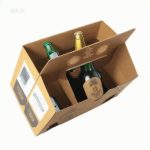
In an era where convenience meets sustainability, foldable food packaging boxes are emerging as the unsung heroes of modern dining. These ingenious containers represent more than just a way to transport your meal—they embody a perfect fusion of practicality, environmental consciousness, and innovative design that’s transforming how we interact with food on the go. From busy professionals grabbing lunch between meetings to families enjoying picnic adventures, foldable packaging is quietly reshaping our culinary landscape.
The magic of foldable food packaging lies in its brilliant simplicity. Constructed from durable yet lightweight materials like reinforced cardboard, biodegradable plastics, or compostable fibers, these boxes arrive flat, springing to life when needed. This space-saving design revolutionizes storage for restaurants and food vendors, allowing them to maximize their limited storage areas while maintaining an abundant supply of packaging materials. The economic benefits are substantial—reduced storage costs, lower shipping expenses for bulk orders, and minimized waste from damaged pre-assembled containers.
Environmental considerations make foldable packaging particularly compelling in today’s eco-conscious market. Many manufacturers now produce these containers using recycled materials, with some options being fully compostable or biodegradable. The reduced storage space translates to fewer delivery trucks on the road, lowering carbon emissions. Furthermore, the efficient design often uses less material than traditional rigid containers without compromising protection or functionality. For businesses aiming to strengthen their sustainability credentials, foldable packaging offers tangible proof of their environmental commitment.
Functionality reaches new heights with modern foldable designs. Advanced engineering ensures these containers maintain structural integrity while protecting contents from crushing or spillage. Many feature secure locking mechanisms that keep food fresh and contained during transport. Some innovative designs incorporate separate compartments for different food items, sauce containers, or even built-in utensils. The thermal properties of certain materials help maintain optimal temperatures, keeping hot foods warm and cold items refreshing—a crucial consideration for food quality and safety.
The versatility of foldable packaging extends across the entire food industry. Food trucks benefit from the compact storage solution, allowing them to carry ample packaging without sacrificing precious workspace. Catering services appreciate how flat-packed boxes simplify logistics and setup at event venues. Meal kit delivery services utilize specialized foldable containers that protect ingredients during shipping while providing convenient preparation surfaces. Even home consumers are discovering the advantages of keeping foldable containers for leftovers, packed lunches, or food sharing with friends and neighbors.
Branding opportunities with foldable packaging are virtually limitless. The flat surface provides an ideal canvas for vibrant printing, custom designs, and promotional messaging. Businesses can transform these functional items into powerful marketing tools that continue promoting their brand long after the food has been enjoyed. The unboxing experience becomes part of the brand story, with clever folding designs creating memorable interactions that customers associate with quality and attention to detail.
As technology advances, so do the capabilities of foldable packaging. Smart packaging innovations include QR codes that link to recipes or nutritional information, temperature-sensitive indicators, and even embedded sensors that monitor food freshness. These technological integrations add value for both businesses and consumers, creating interactive experiences while providing practical benefits. The future may bring even more exciting developments, such as self-folding containers or packaging that can be reused in creative ways by consumers.
The economic advantages for food businesses are substantial and multifaceted. Beyond the obvious storage and shipping benefits, foldable packaging often proves more cost-effective per unit than traditional alternatives. The reduced material usage and manufacturing efficiency contribute to lower production costs, savings that can be passed along to customers or reinvested in other business areas. The durability of well-designed foldable containers also means fewer complaints about damaged goods and reduced need for replacements or refunds.
Consumer response to foldable food packaging has been overwhelmingly positive. The convenience factor resonates strongly with busy individuals who appreciate containers that are easy to store, carry, and dispose of properly. Environmentally conscious customers value the sustainable aspects, while all users benefit from the reliable protection of their food purchases. The psychological appeal of innovative design shouldn’t be underestimated—customers perceive businesses using thoughtful packaging as more modern, caring, and quality-focused.
As we look toward the future of food packaging, foldable solutions stand at the forefront of industry evolution. They represent a harmonious balance between practical necessity and environmental responsibility, between cost efficiency and customer satisfaction. The ongoing development of new materials, designs, and manufacturing processes promises even more sophisticated foldable packaging options in the coming years. For food businesses seeking to enhance their operations, reduce their environmental impact, and delight their customers, embracing foldable packaging isn’t just a smart choice—it’s an essential step toward a more sustainable and efficient future.




Leave a Message